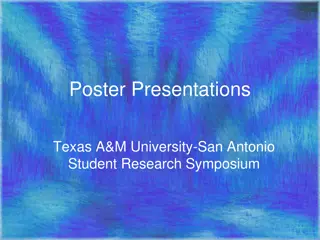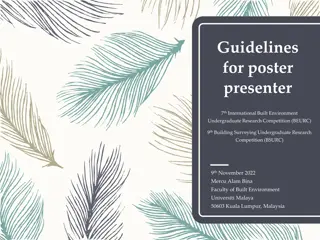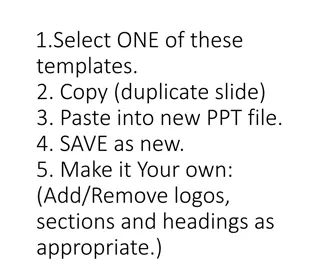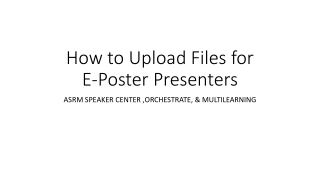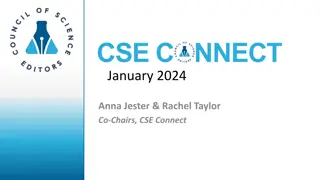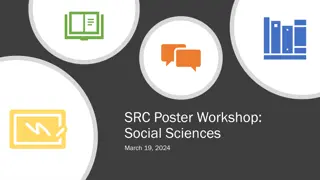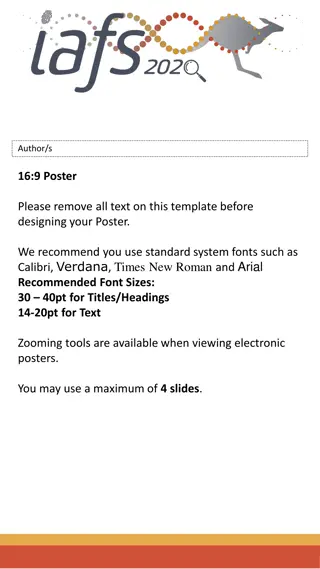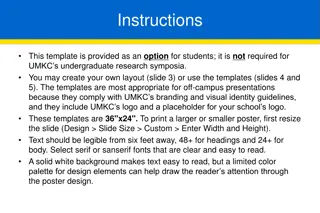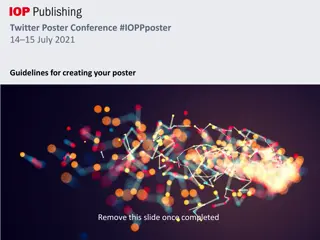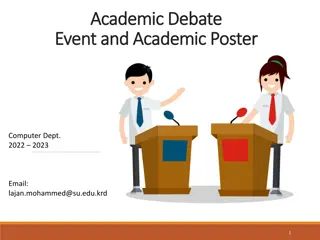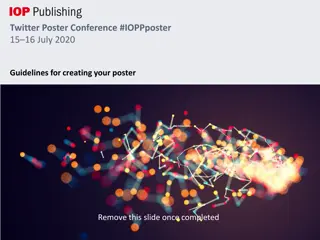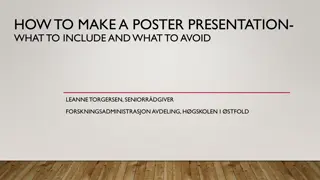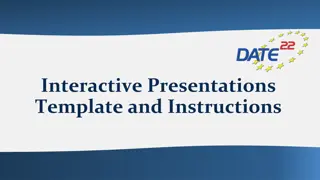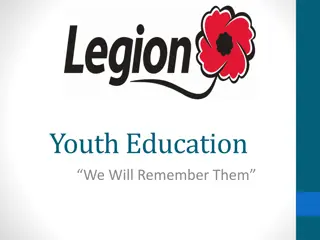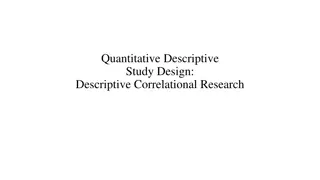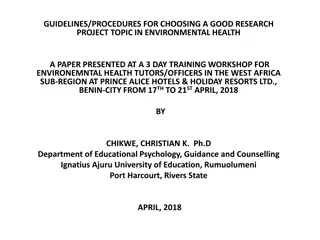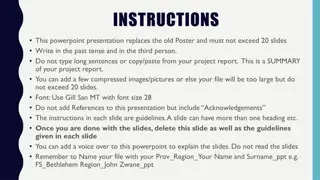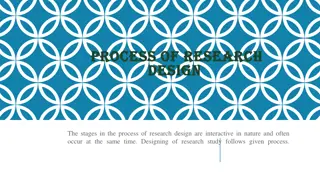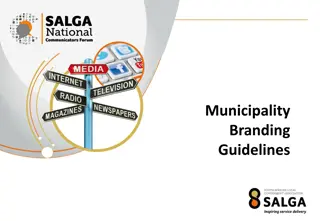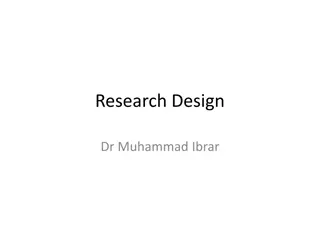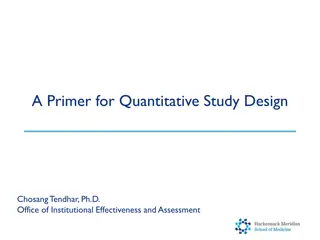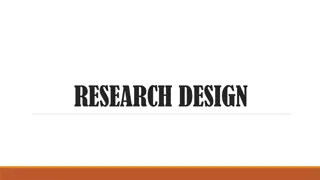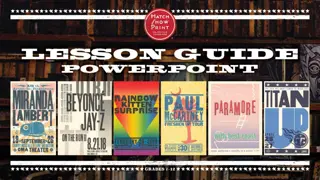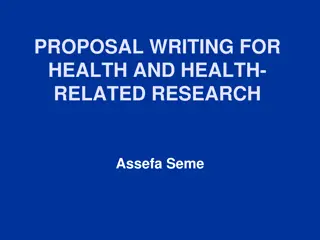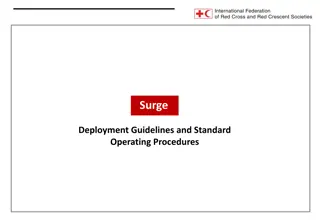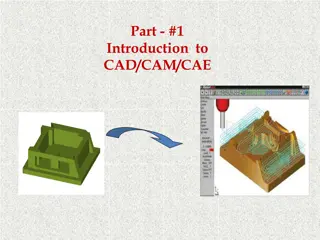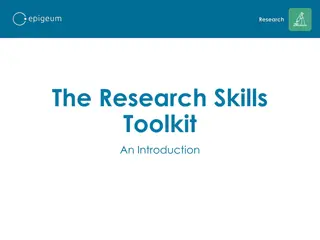Effective Research Poster Design Guidelines
Designing an effective research poster involves using appropriate headings, text sizes, and visual elements like images and charts. Follow the recommended print and screen formats for optimal results. The poster should include sections like Abstract, Introduction, Methodology, Results and Discussions, Conclusions, Acknowledgement, and References. Ensure your poster title is concise, and don't forget to include author names and addresses. Bring your completed poster to MIU for printing after proofreading the draft print.
Download Presentation

Please find below an Image/Link to download the presentation.
The content on the website is provided AS IS for your information and personal use only. It may not be sold, licensed, or shared on other websites without obtaining consent from the author. Download presentation by click this link. If you encounter any issues during the download, it is possible that the publisher has removed the file from their server.
E N D
Presentation Transcript
: A0: 118.9 cm x 84.1 cm A1: 84.1 cm x 59.4 cm A2: 59.4 cm x 42.0 cm A3: 42.0 cm x 29.7 cm www.canva.com ) . . (
Stencil Snappa DesignBold Crello Fotor Piktochart PicMonkey Desygner Adobe Spark
O O Headings Arial Text Times at least 72 point 36-48 point at least 24 point Title Headings Text 24 point Chart labels
Print formats: 600-1200 DPI (dots per inch) TIFF, EPS, WMF, JPG? Screen formats: 72 DPI (dots per inch) GIF, JPG, WMF Scan new color graphics at 150-200 DPI Higher for black and white
(Introduction) (Aims of the research) ) ( Methodology ) ( Results and Discussions ) ( Conclusions
Poster title goes here, containing strictly only the essential number of words... Author s Name/s Goes Here, Author s Name/s Goes Here, Author s Name/s Goes Here Address/es Goes Here, Address/es Goes Here, Address/es Goes Here Printing and Laminating Introduction Introduction Method Method Results Results Once you have completed your poster, bring it down to MIU for printing. We will produce a A3 size draft print for you to check and proof read. The final poster will then be printed First Tips for making a successful poster Importing / inserting files Check with conference organisers on their specifications of size and orientation, before you start your poster eg. maximum poster size; landscape, portrait or square. Re-write your paper into poster format ie. Simplify everything, avoid data overkill. Images such as photographs, graphs, diagrams, logos, etc, can be added to the poster. and laminated. Headings of more than 6 words should be in upper and To insert scanned images into your poster, go through the menus as follows: Insert / Picture / From File then find the file on your computer, select it, and press OK. Note: Do not leave your poster until the last minute. Allow at least 5 working days before you need to use it. The page size of this poster template is A0 (84x119cm), landscape (horizontal) format. Do not change this page size, MIU can scale-to-fit a smaller or larger size, when printing. If you need a different shape start with either a portrait (vertical) or a square poster template. lower case, not all capitals. Never do whole sentences in capitals or underline to stress your point, use bold Simply highlight this text and replace. bold characters instead. The best type of image files to insert are JPEG or TIFF, JPEG is the preferred format. When laying out your poster leave breathing space around you text. Don t overcrowd your poster. Cost Be aware Be awareof the image size you are importing. The average colour photo (13 x 18cm at 180dpi) would be about 3Mb (1Mb for B/W greyscale). Call MIU if unsure. Bear in mind you do not need to fill up the whole space allocated by some conference organisers (eg. 8ftx4ft in the USA). Do not make your poster bigger than necessary just For poster-printing and laminating charges contact to MIU Try using photographs or coloured graphs. Avoid long numerical tables. to fill that given size. Do not not use images from the web. Spell check and get someone else to proof-read. Captions to be set in Times or Times New Roman or equivalent, italic, between 18 and 24 points. Left aligned if it refers to a figure on its left. Caption starts right at the top edge of the picture (graph or photo). Notes about graphs For simple graphs use MS Excel, or do the graph directly in PowerPoint. Graphs done in a scientific graphing programs (eg. Sigma Plot, Prism, SPSS, Statistica) should be saved as JPEG or TIFF if possible. For more information see MIU. Conclusion Conclusion For more information on: Aim Aim Poster Design, Scanning and Digital Photography, Captions to be set in Times or Times New Roman or equivalent, italic, between 18 and 24 points. Right aligned if it refers to a figure on its right. Caption starts right at the top edge of the picture (graph or Captions to be set in Times or Times New Roman or equivalent, italic, between 18 and 24 points. Left aligned if it refers to a figure on its left. Caption starts right at the top edge of the picture (graph or photo). How to use this poster template and Image / file size. Simply highlight this text and replace it by typing in your own text, or copy and paste your text from a MS Word document or a PowerPoint slide presentation. Contact: photo). Medical Illustration Unit Medical Illustration Unit Prince of Wales Hospital The body text / font size should be between 24 and 32 points. Arial, Helvetica or equivalent. Keep body text left-aligned, do not not justify text. Ph: 9382 2800 Email: miunsw@unsw.edu.au Web: http://miu.med.unsw.edu.au The colour of the text, title and poster background can be changed to the colour of your choice. Acknowledgements Acknowledgements Just highlight this text and replace with your own text. Replace this with your text. Captions to be set in Times or Times New Roman or equivalent, italic, 18 to 24 points, to the length of the column in case a figure takes more than 2/3 of column width. Captions to be set in Times or Times New Roman or equivalent, italic, 18 to 24 points, to the length of the column in case a figure takes more than 2/3 of column width.
Poster title goes here, containing strictly only the essential number of words... Author s Name/s Goes Here, Author s Name/s Goes Here, Author s Name/s Goes Here Address/es Goes Here, Address/es Goes Here, Address/es Goes Here Introduction Method Results First Tips for making a successful poster Importing / inserting files Printing and Laminating Check with conference organisers on their specifications of size and orientation, before you start your poster eg. maximum poster size; landscape, Re-write your paper into poster format ie. Simplify everything, avoid data overkill. Images such as photographs, graphs, diagrams, logos, etc, can be added to the poster. Once you have completed your poster, bring it down to MIU for printing. We will produce a A3 size draft print for you to check and proof read. The final poster will then be printed and laminated. Headings of more than 6 words should be in upper and lower case, not all capitals. To insert scanned images into your poster, go through the menus as follows: Insert / Picture / From File then find the file on your computer, select it, and press OK. portrait or square. The page size of this poster template is A0 (84x119cm), landscape (horizontal) format. Do not change this page size, MIU can scale-to-fit a smaller or larger size, when printing. If you need a different shape start with either a portrait (vertical) or a square poster template. Note: Do not leave your poster until the last minute. Allow at least 5 working days before you need to use it. Never do whole sentences in capitals or underline to stress your point, use bold characters instead. When laying out your poster leave breathing space around you text. Don t overcrowd your poster. The best type of image files to insert are JPEG or TIFF, JPEG is the preferred format. Simply highlight this text and replace. Be aware of the image size you are importing. The average colour photo (13 x 18cm at 180dpi) would be about 3Mb (1Mb for B/W greyscale). Call MIU if unsure. Try using photographs or coloured graphs. Avoid long Cost Bear in mind you do not need to fill up the whole space allocated by some conference organisers (eg. 8ftx4ft in the USA). Do not make your poster bigger than necessary just to fill that given size. numerical tables. For poster-printing and laminating charges contact to Do not use images from the web. Spell check and get someone else to proof-read. MIU Notes about graphs Captions to be set in Times or Times New Roman or equivalent, italic, between 18 and 24 points. Left aligned if it refers to a figure on its left. Caption starts right at the top edge of the picture (graph or photo). For simple graphs use MS Excel, or do the graph directly in PowerPoint. Graphs done in a scientific graphing programs (eg. Sigma Plot, Prism, SPSS, Statistica) should be saved as JPEG or TIFF if possible. For more information see MIU. Conclusion Aim For more information on: Captions to be set in Times or Times New Roman or equivalent, italic, between 18 and 24 points. Right aligned if it refers to a figure on its right. Caption starts right at the top edge of the picture (graph or Captions to be set in Times or Times New Roman or equivalent, italic, between 18 and 24 points. Left aligned if it refers to a figure on its left. Caption starts right at the top edge of the picture (graph or photo). Poster Design, Scanning and Digital Photography, How to use this poster template and Image / file size. Simply highlight this text and replace it by typing in your own text, or copy and paste your text from a MS Word document or a PowerPoint slide presentation. Contact: photo). Medical Illustration Unit Prince of Wales Hospital The sub-title text boxes can be moved up or down depending on how big or small your Introduction , Aim , Method , Results and Conclusion are. Ph: 9382 2800 Email: miunsw@unsw.edu.au Web: http://miu.med.unsw.edu.au The body text / font size should be between 24 and 32 points. Arial, Helvetica or equivalent. Keep body text left-aligned, do not justify text. The colour of the text, title and poster background can be changed to the colour of your choice. Acknowledgements Just highlight this text and replace with your own text. Replace this with your text. Captions to be set in Times or Times New Roman or equivalent, italic, 18 to 24 points, to the length of the column in case a figure takes more than 2/3 of column width. Captions to be set in Times or Times New Roman or equivalent, italic, 18 to 24 points, to the length of the column in case a figure takes more than 2/3 of column width.
Title that hints at the underlying issue or question and is formatted in sentence case This means only the t in title gets capitalized. Maintain a good amount of space between your columns. Although you could squeeze them right up against each other, the poster s aesthetics would suffer. Your name(s) here Department of Biology, Swarthmore College, Swarthmore, Pennsylvania 19081 Make sure the edges of your columns are aligned with adjacent columns. Don t trust your eyes: select the columns, then Align with the proper tool This is a header. If you make the font size large, and then add bolding there is no need to also apply underlining or italicization. If you can orient your label horizontally, viewers with fused neck musculature are more likely to read it. Introduction Results Conclusions Rats with brains navigate mazes faster This is a Microsoft Powerpoint template that has column widths and font sizes optimized for printing a 36 x 56 poster just replace the tips and blah, blah, blah repeat motifs with actual content, if you have it. Try to keep your total word count under 500 (yea, this suggestion applies to everyone, even you). More tips can be found at the companion site, Advice on designing scientific posters, at the Swarthmore College Biology Department web site. This paragraph has justified margins, but be aware that simple left-justification (other paragraphs) is infinitely better if your font doesn t space nicely when fully justified. Sometimes spacing difficulties can be fixed by manually inserting hyphens into longer words. (Powerpoint doesn t automaticallyhyphenate, by the way.) Your main text is easier to read if you use a serif font such as Palatino or Times (i.e., people have done experiments and found this to be the case). Use a non-serif font for your title and section headings. The overall layout for this section can, and probably should, be modified from this template, depending on the size and number of charts and photographs your specific experiment generated. You might want a single, large column to accommodate a large map, or perhaps you could arrange 6 figures in a circle in the center of the poster: do whatever it takes to make your results graphically clear. To see examples of how others have abused this template to fit their presentation needs, perform a Google search for powerpoint template for scientific posters. Paragraph format is fine, but sometimes a simple list of bullet points can communicate results more effectively: You can, of course, start your conclusions in column #3 if your results section is data light. Brainectomized Time (s) Conclusions should not be mere reminders of your results. Instead, you want to guide the reader through what you have concludedfrom the results. What is the broader significance? Would anyone be mildly surprised? Why should anyone care? This section should refer back, explicitly, to the burning issue mentioned in the introduction. If you didn t mention a burning issue in the introduction, go back and fix that -- your poster should have made a good case for why this experiment was worthwhile. The first sentence of the first paragraph does not need to be Control (brain intact) indented. Maze difficulty index Figure 4. Avoid keys that force readers to labor through complicated graphs: just label all the lines (or bars) and then delete the silly key altogether. The above figure would also be greatly improved if I had the ability to draw mini rats with and without brains. I would then put these little illustrations next to the 9 out of 12 brainectomized rats survived Control rats completed maze faster, on average, than rats without brains (Fig. 3b) (t = 9.84, df = Blah, blah, blah. Blah, blah, blah. Blah, blah, blah. Blah, blah, blah. Blah, blah, blah. Blah, blah, blah. Blah, blah, blah. Blah, blah, blah. Blah, blah, blah. Blah, blah, blah. Blah, blah, blah. Blah, blah, blah. Blah, blah, blah. Blah, blah, blah. Blah, blah, blah. Blah, blah, blah. Blah, blah, blah. Blah, blah, blah. Blah, blah, blah. Blah, blah, blah. Blah, blah, blah. Blah, blah, blah. Blah, blah, blah. lines they represent. 21, p = 0.032) Be sure to separate figures from other figures by generous use of white space. When figures are too cramped, viewers get confused about which figures to read first and which legend goes with which figure. Figures are preferred but tables are sometimes unavoidable. A table looks best when it is first composed within Microsoft Word, then Inserted as an Object. If you can add small drawings or icons to your tables, do so! (b) (c) (a) Blah, blah, blah. Blah, blah, blah. Blah, blah, blah. Blah, blah, blah. Blah, blah, blah. Blah, blah, blah. Blah, blah, blah. Blah, blah, blah. Materials and methods Be brief, and opt for photographs or drawings whenever possible to illustrate organism, protocol, or experimental design. Viewers don t actually want to read about the gruesome details, however fascinating you might find them. Blah, blah, blah. Blah, blah, blah. Blah, blah, blah. Blah, blah, blah. Blah, blah, blah. Blah, blah, blah. Blah, blah, blah. Blah, blah, blah. Blah, blah, blah. Blah, blah, blah. Blah, blah, blah. Blah, blah, blah. Blah, blah, blah. Blah, blah, blah. Blah, blah, blah. Blah, blah, blah. Blah, blah, blah. Blah, blah, blah. Blah, blah, blah. Blah, blah, blah. Blah, blah, blah. Blah, blah, blah. Blah, blah, blah. Blah, blah, blah. Blah, blah, blah. Blah, blah, blah. Remember: no period after journal name. Literature cited Figure 3. Make sure legends have enough detail to fully explain to the viewer what the results are. Note that for posters it is good to put some Materials and methods information within the figure legends or onto the figures themselves it allows the M&m section to be shorter, and gives viewer a sense of the experiment(s) even if they have skipped directly to figures. Don t be tempted to reduce font size in figure legends, axes labels, etc. your viewers are probably most interested in reading your figures and legends! Bender, D.J., E.M Bayne, and R.M. Brigham. 1996. Lunar condition influences coyote (Canis latrans) howling. American Midland Naturalist 136:413-417. Brooks, L.D. 1988. The evolution of recombination rates. Pages 87-105 in The Evolution of Sex, edited by R.E. Michod and B.R. Levin. Sinauer, Sunderland, MA. Scott, E.C. 2005. Evolution vs. Creationism: an Introduction. University of California Press, Berkeley. Society for the Study of Evolution. 2005. Statement on teaching evolution. < http://www.evolutionsociety.org/statements.html >. Accessed 2005 Aug 9. Often you will have some more text-based results between your figures. This text should explicitly guide the reader This area is white space that adds tremendously to the readability of your poster. Resist the urge to fill it with text. Yea, this means you. Abutting these last sections can save you a little space, and subtly indicates to viewers that the contents are not as important to read. through the figures. Acknowledgments I sure wish I d presented my theory with a poster before I wrote my book. chuckdhasaposse We thank I. G or for laboratory assistance, Mary Juana for seeds, Herb Isside for applying the greenhouse stress treatment, and M.I. Menter for statistical advice and scintillating discussions. Funding for this project was provided by the Swarthmore College Department of Biology, a Merck summer stipend, and my mom. [Note that people s titles are omitted.] Blah, blah, blah (Figs. 3a,b). Blah, blah, blah. Blah, blah, blah. Blah, blah, blah. Blah, blah, blah. Blah, blah, blah. Blah, blah, Put a figure here that explores a statistical result blah. Blah, blah, blah. Figure 1. Photograph or drawing of organism, chemical structure, or whatever. Don t use graphics from the web (they look terrible when Blah, blah, blah. Blah, blah, blah. Blah, blah, blah. Blah, blah, blah. Blah, blah, blah. Blah, blah, blah. Blah, blah, blah. Blah, blah, blah (Fig. 3c). Blah, blah, blah. Blah, blah, blah. Blah, blah, blah. Blah, blah, blah. Blah, blah, blah. Blah, blah, blah This is the gene of interest! printed). (data not shown). Same for this space. For further information Please contact email@swarthmore.edu. More information on this and related projects can be obtained at www.swarthmore (give the URL for general laboratory web site). A link to an online, PDF-version of the Figure 5. You can use connector lines and arrows to visually guide viewers through your results. Making logical points this way is much, much better than making it in the text section. These lines can help viewers read your poster even when you re not present. Blah, blah, blah. Blah, blah, blah. Blah, blah, blah. Blah, blah, blah. Blah, blah, blah. Blah, blah, blah. Blah, blah, blah. Blah, blah, blah. Blah, blah, blah. Blah, blah, blah (God, personal Figure 2. Illustration of important piece of equipment, or perhaps a flow chart summarizing experimental design. Scanned, hand-drawn illustrations are usually preferable to computer- poster is nice, too. communication). If you just must include a pretentious logo, hide it down here. But don t include a pretentious logo. Use the space for something else. Blah, blah, blah. Blah, blah, blah. However, blah, blah, blah. generated ones.
This is the Title of Your Presentation Your Name, Title, Affiliation Introduction and Objectives Methodology Study conclusions and ideas for new research Lay in your introduction x x x x x x x x x x xxxxxxxxxxxxxxxxxxxxxxxxxxxxxxxxxxxxxxxxxxxxxxxxxxxx x Population Studied x x x x x Discussions x x x x x x x x xx xxxxxxxxxxxxxxxxx x x 90 80 70 60 50 East West North 40 x 30 20 Funding Source 10 xxxxx xxxxxxxx 0 1st Qtr 2nd Qtr 3rd Qtr 4th Qtr
References 1- fac.ksu.edu.sa sites default files lmlsq_llmy 2- https://1biblothequedroit.blogspot.com 3- http://forums.arabsbook.com/threads/48346/ 4- https://www.almrsal.com/post/510288 5- https://www.aoua.com/vb/showthread.php?t=109279


